The AMD Radeon R9 Fury X Review: Aiming For the Top
by Ryan Smith on July 2, 2015 11:15 AM ESTGrand Theft Auto V
The final game in our review of the R9 Fury X is our most recent addition, Grand Theft Auto V. The latest edition of Rockstar’s venerable series of open world action games, Grand Theft Auto V was originally released to the last-gen consoles back in 2013. However thanks to a rather significant facelift for the current-gen consoles and PCs, along with the ability to greatly turn up rendering distances and add other features like MSAA and more realistic shadows, the end result is a game that is still among the most stressful of our benchmarks when all of its features are turned up. Furthermore, in a move rather uncharacteristic of most open world action games, Grand Theft Auto also includes a very comprehensive benchmark mode, giving us a great chance to look into the performance of an open world action game.
On a quick note about settings, as Grand Theft Auto V doesn't have pre-defined settings tiers, I want to quickly note what settings we're using. For "Very High" quality we have all of the primary graphics settings turned up to their highest setting, with the exception of grass, which is at its own very high setting. Meanwhile 4x MSAA is enabled for direct views and reflections. This setting also involves turning on some of the advanced redering features - the game's long shadows, high resolution shadows, and high definition flight streaming - but it not increasing the view distance any further.
Otherwise for "High" quality we take the same basic settings but turn off all MSAA, which significantly reduces the GPU rendering and VRAM requirements.
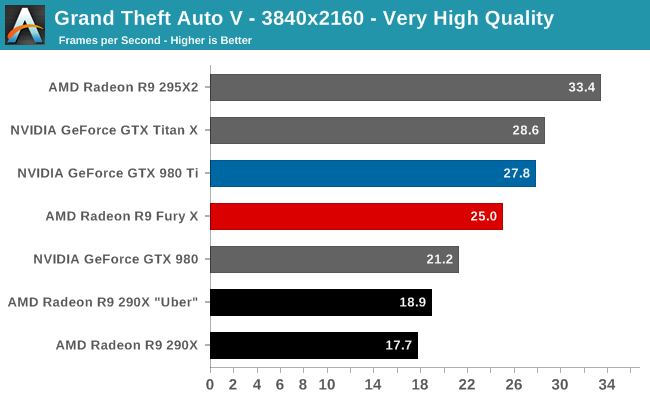
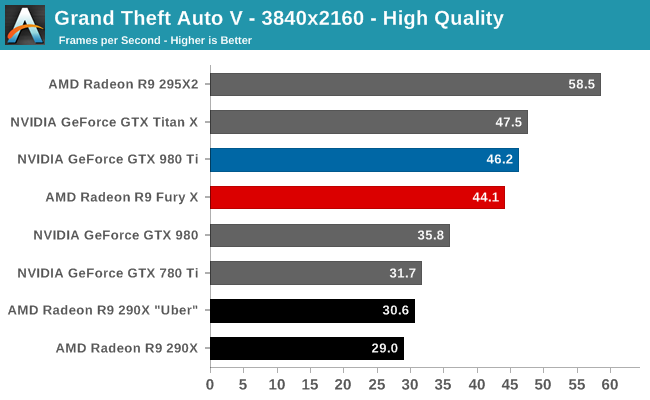
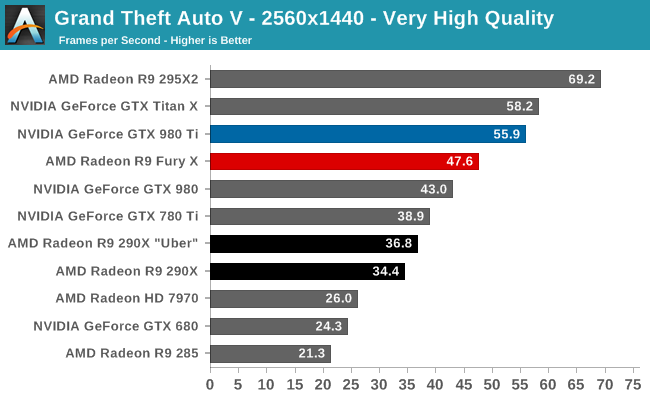
Our final game sees the R9 Fury X go out on either an average or slightly worse than average note, depending on the settings and resolution we are looking at. At our highest 4K settings the R9 Fury X trails the GTX 980 Ti once again, this time by 10%. Worse, at 1440p it’s now 15%. On the other hand if we run at our lower, more playable 4K settings, then the gap is only 5%, roughly in line with the overall average 4K performance gap between the GTX 980 Ti and R9 Fury X.
In this case it’s probably to AMD’s benefit that our highest 4K settings aren’t actually playable on a single GPU card, as the necessary drop in quality gets them closer to NVIDIA’s performance. On the other hand this does reiterate the fact that right now many games will force a tradeoff between resolution and quality if you wish to pursue 4K gaming.
Finally, the performance gains relative to the R9 290X are pretty good. 29% at 1440p, and 44% at the lower quality playable 4K resolution setting.
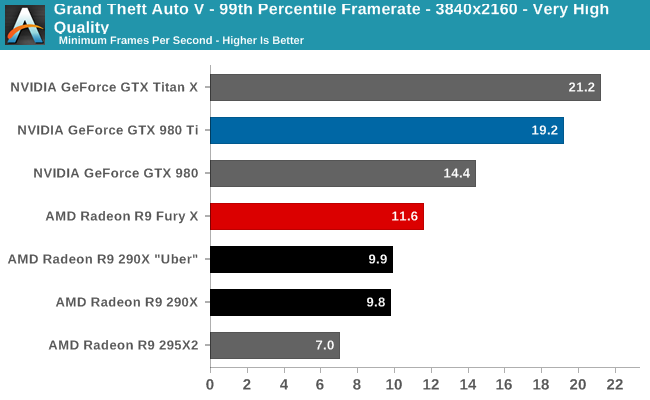
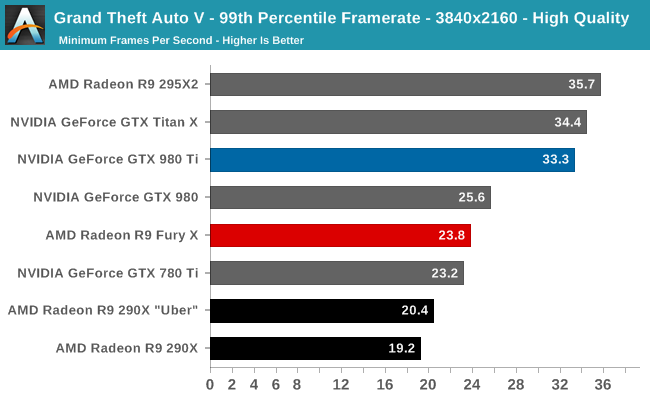
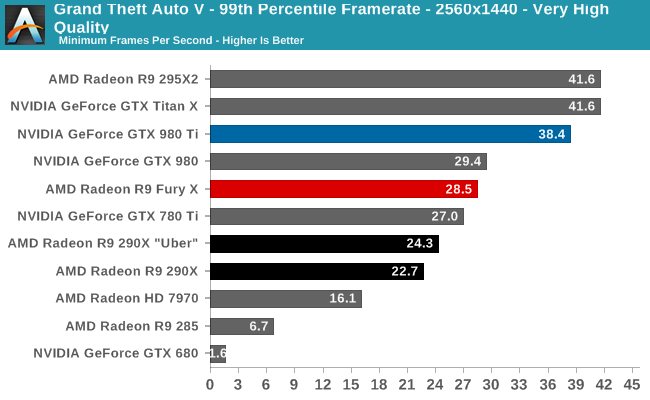
Shifting gears to 99th percentile frametimes however – a much-welcome feature of the game’s built-in benchmark – finds that AMD doesn’t fare nearly as well. At the 99th percentile the R9 Fury X trails the GTX 980 Ti at all times, and significantly so. The deficit is anywhere between 26% at 1440p to 40% at 4K Very High.
What’s happening here is a combination of multiple factors. First and foremost, next to Shadow of Mordor, GTAV is our other VRAM busting game. This, I believe, is why 99th percentile performance dives so hard at 4K Very High for the R9 Fury X, as it only has 4GB of VRAM compared to 6GB on the GTX 980 Ti. But considering where the GTX 980 places – above the R9 Fury X – I also believe there’s more than just VRAM bottlenecking occurring here. The GTX 980 sees at least marginally better framerates with the same size VRAM pool (and a lot less of almost everything else), which leads me to believe that AMD’s drivers may be holding them back here. Certainly the R9 290X comparison lends some possible credit to that, as the 99th percentile gains are under 20%. Regardless, one wouldn’t expect to be VRAM limited at 1440p or 4K without MSAA, especially as this test was not originally designed to bust 4GB cards.










458 Comments
View All Comments
TallestJon96 - Saturday, July 4, 2015 - link
This card is not the disappointment people make it out to be. One month ago this card would have been a MASSIVE success. What is strange to me is that they didn't reduce price, even slightly to compete with the new 980 ti. I suspect it was to avoid a price war, but I would say at $600 this card is attractive, but at $650 you only really want it for water cooling. I suspect the price will drop more quickly than the 980 ti.mccoy3 - Saturday, July 4, 2015 - link
So it is as expensive as the 980Ti by delivering less performance and requires watercooling. Once Nvidia settles for a TITAN Y including HBM, its all over for the red guys.just4U - Saturday, July 4, 2015 - link
Well that would be great news for AMD though wouldn't it since Nvidia would have to pay for the use of HBM in some form or another..Oxford Guy - Saturday, July 4, 2015 - link
AMD could have released a hot leaf blower like the GTX 480 and chose not to.chizow - Monday, July 6, 2015 - link
No, they couldn't have. Fury X is already a 275W and that's with the benefit of low temp leakage using a WC *AND* the benefit of a self-professed 15-20W TDP surplus from HBM. That means in order for Fury X to still fall 10% short of 980Ti, it is already using 25+20W, so 45W more power.Their CUSTOM cooled 7/8th cut Fury is going to be 275W typical board power as well and its cut down, so yeah the difference in functional unit power is most likely going to be the same as the difference in thermal leakage due to operating temperatures between water and custom air cooling. A hot leaf blower, especially one as poor as AMD's reference would only be able to cool a 6/8 cut Fiji or lower, but at that point you might as well get a Hawaii based card.
Oxford Guy - Thursday, July 9, 2015 - link
Your posts don't even try to sound sane. I wrote about the GTX 480, which was designed to run hot and loud. Nvidia also couldn't release a fully-enabled chip.Ignore the point about the low-grade cooler on the 480 which ran hot and was very loud.
Ignore the point about the card being set to run hot, which hurt performance per watt (see this article if you don't get it).
How much is Nvidia paying you to astroturf? Whatever it is, it's too much.
Margalus - Monday, July 6, 2015 - link
this AMD card pumps out more heat than any NVidia card. Just because it runs a tad cooler with water cooling doesn't mean the heat is not there. It's just removed faster with water cooling, but the heat is still generated and the card will blow out a lot more hot air into the room than any NVidia card.Oxford Guy - Friday, July 10, 2015 - link
If you can't afford AC then stick with something like a 750 Ti. Otherwise the extra heat is hardly a big deal.zodiacfml - Saturday, July 4, 2015 - link
My excitement with HBM has subsided as I realized that this is too costly to be implemented in AMD's APUs even next year. Yet, I hope they do as soon as possible even if it would mean HBM on a narrower bus.jburns - Saturday, July 4, 2015 - link
Probably the best graphics card review I've ever read! Detailed and balanced... Thanks Ryan for an excellent review.